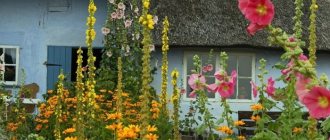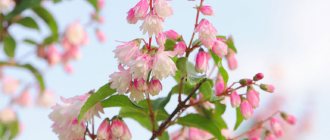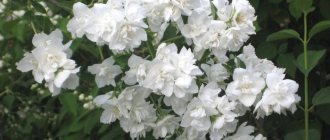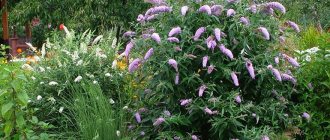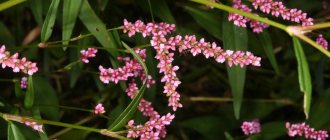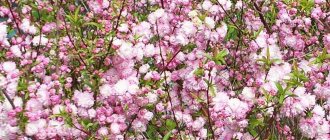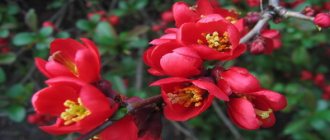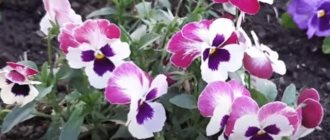A shrub with yellow leaves can decorate any garden plot. There are crops that are used to design and form exotic compositions at any time of the year. It’s hard to believe, but there are shrubs with yellow leaves that delight with their cheerfulness from the beginning of April until the end of November. Many crops for decorative planting in the garden can be easily cultivated by simple gardeners and summer residents.
We suggest you find out the names of shrubs with yellow leaves - on this page we have collected a collection of the most interesting and original plants that can be grown in the Moscow region and other regions of our country.
An ornamental shrub with yellow leaves will create an excellent composition and will easily shade beautiful flowering plants; it looks great in compositions with conifers (pines, spruce, thuja, cypress, etc.).
We advise you to pay attention to the following common shrubs with yellow leaves - they are widespread and known to many summer residents:
- oval-leaved privet “Aureum”;
- Fortune's euonymus 'Emerald'n Gold';
- Japanese euonymus "Aureovariegatus";
- elderberry "Plumosa Aurea";
- common hazel "Aurea";
- Spiraea japonica 'Goldflame'.
Look at the names and photos of shrubs with yellow leaves on this page and continue the fascinating excursion into their diversity:
Look at the photo of a bush with yellow leaves
Honey locust (Gleditsia triacanthos) “Sunburst”
An ornamental shrub with yellow leaves, honey locust three-spined is a small plant, often low-branched, with a wide, sparse, irregular crown. Reaches 10 m in height and 6 m in width. Young leaves of Gleditsia triacanthos are golden yellow, later light green, and light brown in autumn. Does not set fruit.
The landing site is sunny. It is undemanding to soils. One of the most beautiful trees with yellow color. The best place for planting is in gardens and parks against a background of darker plants. Also, despite the name, it has no thorns.
Honey locust (Gleditsia triacanthos) variety “Sunburst” belongs to the legume family (Fabaceae).
Decorative: One of the most beautiful plants with a yellow color. Young leaves are golden yellow, later light green.
Description: A small ornamental shrub with yellow leaves, often low-branched, with a wide, sparse, irregular crown. Reaches 10 m in height and 6 m in width. Young leaves are golden yellow, later light green, and light brown in autumn. Does not set fruit. It is undemanding to soils. Gledicia is easily replanted, resistant to urban conditions, air pollution, and drought-resistant. One of the most beautiful trees with yellow color. The best place for planting is in gardens and parks against a background of darker plants. The variety has no thorns. Lives up to 300 years.
- Use: landscaping gardens and parks.
- Flowering: Forms white small inflorescences in June.
- Fruit: does not set fruit.
- Location: Three-spined honey locust is light-loving, so it is necessary to plant it in illuminated areas.
- Watering: not demanding on watering, drought-resistant.
- Pruning, haircut: pruning of the plant is carried out in the spring, both sanitary and formative
Preparation for winter: frost-resistant.
Chubushnik: photo and description of the bush
The spring parade will smoothly end and lead us into summer with the divine aroma of mock orange, blooming at the very end of May and beginning of June. Few flower growers call it “jasmine” in the old fashioned way, calling this fragrant shrub by its correct name – mock orange.
Mock orange (Philadelphus).
It is necessary to choose mock orange varieties especially thoughtfully, as there are several pitfalls here. For example, some varieties of mock orange (most often double) may not have that same jasmine aroma for which a summer resident often decides to plant a bush.
Also remember that some dwarf varieties of mock orange (for example, “Gnome”) practically do not bloom. Another difficulty is associated with the low winter hardiness of certain species of this shrub. In particular, garden departments often sell numerous varieties of Lemoine mock orange , which regularly freezes over in the middle zone, and in some severe winters it can even freeze completely.
Deciduous catalpa bignonioides (Catalpa bignonioides)
Catalpa bignonioides belongs to the Bignoniaceae family. This shrub with yellow leaves is native to the southeastern part of North America, where it is found along river banks.
It is a picturesque deciduous plant up to 15 m high (in Russia, the average height of catalpa is 6 - 7 m). Can grow as a multi-stemmed shrub.
Catalpa has a rounded, rather spreading crown, which provides a lot of shade. The leaves are arranged oppositely, sometimes whorled. They are whole petiolate, large, velvety heart-shaped, up to 30 cm long and 17 cm wide.
Catalpa blooms in June. At this time, the tree is strewn with large, paniculate, erect, candle-shaped inflorescences. The flowers are creamy-white, funnel-shaped, up to 5 cm long. Inside the flower, in the throat, red spots, dots and two yellow strokes are visible, the edge of the petals is slightly corrugated.
The fruit of the catalpa is a long, hanging down, pod-like, dark brown capsule, its length is about 40 cm. Inside there are flying seeds. Even after the leaves open and the seeds fall out, the fruits remain hanging on the branches, giving the tree a very unusual and original appearance.
Catalpa grows quite quickly. Flowering can be observed starting from the 5th year. In autumn, the leaves remain green almost until the last moment and fall off only after frost.
Breeders have developed several decorative forms of bignonia catalpa. This is catalpa bignonia "Aurea" (golden) with bright yellow leaves, often grown as a coppice crop; catalpa bignoniiformes "Koehnei" (Kene) - with yellow leaves with a dark green spot in the center of the leaf blade and prominent green veins; catalpa bignoniiformes "Nana" (dwarf form of ornamental shrub with yellow leaves). The latter is often grafted onto a standard; it is more winter-hardy than species plants and is promising for cultivation in central Russia.
Catalpas look interesting both as single plants and as elements of decorative groups. In southern parks they go well with magnolias, holly, and oriental liquidambar.
Catalpas are light-loving, but can grow in partial shade. They are undemanding to soil conditions; they prefer fresh, well-moistened, drained, rich in organic matter, loamy soils with pH=7. This plant is drought and heat resistant, practically does not suffer from diseases and pests, and thrives in urban conditions. With regular watering, the tree develops better and produces more growth. It responds well to fertilizing with mineral and organic (for example, slurry) fertilizers.
The experience of introducing catalpa bignoniiformes in the Moscow botanical gardens of the Russian Federation has shown that the winter hardiness of plants within this species largely depends on the geographical origin of the seeds and cuttings from which the seedlings are grown. That is, you should choose plants grown in the areas closest to you.
In terms of winter hardiness, catalpa can be classified in USDA zone 5. The growths of young plants in the conditions of the Moscow region often freeze slightly; in the summer the tree restores its crown. Winter hardiness improves with age, but it is still better to tie the trees with spruce branches for the winter. In spring, damaged shoots must be pruned.
Shrubs with yellow leaves (“Aurea”) can freeze to the ground in winter and grow back in summer. That is, this variety is used as a perennial or low shrub.
Catalpa can be propagated by seeds and summer cuttings. Seeds are sown in autumn or spring, in greenhouses or in open ground. Cuttings are rooted in the summer under film. Rooting without stimulants is approximately 50%.
Look at the photo of a shrub with yellow leaves - its name can be seen on the page above:
Reproduction
Under amateur conditions, propagation of mahonia holly is carried out by cuttings, seeds, layering and root suckers.
Seeds
The seeds are cleared of pulp and sown in pots in the fall. Stratification is definitely needed. Self-seeding can also be used. At first they grow slowly, but when they take root well, they begin to grow rapidly.
Herbaceous and woody cuttings
The shrub is very easily propagated by cuttings. The procedure is carried out at the end of summer. How to propagate mahonia by cuttings - step by step:
- Cuttings are cut in August and rooted in the ground. Cuttings should be taken from side shoots, the length of which in August is 5-10 cm.
- The tip of the cuttings should be immersed in a rooting agent and planted in sand - at a temperature of 18-20 ° C.
- When the seedling begins to take root, it should be transplanted into a mixture of sand and peat in a 1:1 ratio.
- The next step is to leave it in a cool room for the winter - at a temperature of 10-12 ° C.
- In spring, seedlings should be planted in light soil and grown in it for 1-2 years.
Root suckers
Mahonia reproduces most easily by root suckers. You can see numerous shoots around the bush; they can be separated from the plant and planted in the right place.
By layering
You can also propagate mahonia by layering (the shoots take root on their own after contact with the ground). This is a very simple way. To propagate a bush in this way, you need to bend a healthy flexible shoot to the ground, tear off the leaves and secure it to the ground, covering it with a layer of soil. The next step is to water the place where we made the layering and check whether the young plants have taken root. After rooting, the cuttings are separated from the mother bush.
Decorative black elderberry "Aurea"
An ornamental shrub with yellow leaves, black elderberry "Aurea" is very bright with a spreading crown. It reaches a maximum height of 2.5 m. Crown shapes are formed by pruning. It can be vertical, oval and tent-shaped (up to two and a half meters in diameter). Main characteristics:
- smooth, gray bark;
- leaves are odd-pinnate, light green in color, tips are golden-yellowish, about 30 cm;
- whitish flowers, arranged in clusters-inflorescences;
- juicy, black with shine, small edible berries;
- Basically it is a frost-resistant plant.
What similar varieties of shrubs are there with yellow leaves? A spreading deciduous shrub - Elderberry black "Laciniata" - has a light, almost "airy" openwork crown up to three m in diameter. Light gray bark. Large spreading greenish leaves. White small flowers. The berries are black and purple, not large, suitable for eating.
Both of these varieties prefer light and sun, or at least partial shade. Fast growing. They tolerate crowning well. They love saturated and moist soils. In severe frosts, young plants need shelter. They rarely get sick. The main pest is aphids. They take root well in the garden, either alone or in a group, and combine perfectly with other perennial plants.
The red Elderberry, Plumosa aurea cystica, will become a real decoration for your garden plot. It reaches a maximum of three meters in height and width. Drought resistant. Grows on any soil. Tolerates cold winters well.
The color of the foliage of this shrub ranges from yellow to golden, which is why it is valued among gardeners. Because it perfectly dilutes the green color. The flowers are small, yellowish-green. Red berries are inedible. Anti-aging pruning is carried out every 2-3 years, but crowning is carried out up to 4 times per season. Depending on the desired plant shape.
The fruits of black elderberry are mainly eaten. They are harvested when fully ripe in September. How are they valued? Elderberries “Laciniata” and “Aurea” are rich in:
- vitamin C;
- carotene;
- sambucin;
- glucose;
- fructose;
- malic acid;
- amino acids;
- tyrosine.
They contain tannins and dyes. Juice, wine, jam, and various medicinal tinctures are made from ripe black fruits. These products serve as an excellent prophylactic agent in the treatment of oncology. In folk medicine they are used to increase immunity, help with constipation, stomach problems, varicose veins, and increase overall tone.
The only thing to keep in mind is that elderberry contains toxins. Therefore, it is necessary to strictly follow the manufacturing technology and in no case exceed the dosage.
Grow, shape, cook and enjoy your creations. In addition, the decorative appearance can be prepared as a medicinal tincture, which also has its great advantages. Strengthening the human immune system thanks to even the ornamental elderberry will be no worse if it were some other variety of it.
Look at the photo below for a shrub with yellow leaves: its name is presented on the page above:
Rhododendron: early flowering shrub, photo and description
Numerous varieties of dazzling evergreen rhododendrons captivate the hearts of gardeners every year, but their cultivation is fraught with a number of difficulties, in particular related to the need to provide winter shelter. But in the rows of rhododendrons there are also deciduous varieties that are more suitable for growing in the conditions of the Middle Zone.
Daurian rhododendron (Rhododendron dauricum).
One of the most unpretentious and early-flowering deciduous rhododendrons is Daurian rhododendron , also known as wild rosemary . Blooming wild rosemary resembles a pink haze, its flowers are smaller and not as exotic as those of varietal rhododendrons, but still its delicate beauty is a welcome decoration for the garden in spring.
Since this shrub is a natural species that grows in a fairly cool climate (in Russia it can be found in Eastern Siberia and the Far East), it will not cause any problems for the gardener and will not require special care and shelter for the winter (ledum wood tolerates frosts up to -45 degrees).
However, when growing wild rosemary, it is important to remember one unpleasant property of the plant - the sharp camphorous smell of rosemary flowers has a negative effect on humans, in particular, causing headaches, dizziness and weakness. In addition, all parts of the plant are poisonous.
In this regard, it is not recommended to plant shrubs near recreational areas, as well as to grow them in the form of massifs, but a small bush in the far corner of the garden will not harm anyone.
Dahurian rhododendron blooms very early; its flowering can begin even during a long thaw at the end of winter or in March, but most often this shrub blooms in April. The duration of flowering depends greatly on weather conditions and can range from 10 days to a month.
Daurian rhododendron does not grow quickly, but at the age of 20 it can reach a height of two meters. The key to success when growing rhododendron is planting in the right soil. Like all rhododendrons, wild rosemary needs acidic soils, therefore, if your site has a neutral, and even more so alkaline, soil reaction, then you definitely need to prepare planting holes for the plant.
It is recommended to remove all soil from the prepared planting site and replace it with acidic peat mixed with sand, pine needles and leaf soil, or purchase special soil for heather crops.
Dahurian rhododendron is a moisture-loving plant, so it will grow well on the shore of a reservoir or in areas prone to spring flooding. In summer, during the dry period, wild rosemary must be watered.
Japanese azalea (Azalea japonica).
An interesting plant - Thunberg barberry "Aurea"
To create colorful landscape accents - hedges, solitaire compositions, unpretentious shrubs with yellow leaves are used. The medium-sized Thunberg barberry "Aurea" is an interesting plant, which is characterized by a lemon-yellow color of the crown. The plant is undemanding to cultivation conditions, so independent planting is possible in a summer cottage or suburban area. Barberry Thunberg "Aurea" - an ornamental shrub with yellow leaves for decorating a suburban area
The Latin name of the deciduous shrub is aurea, which means “golden”. The foliage of the crop appears illuminated by the sun due to its yellow color, which changes to orange in the fall. Agronomists identify several varietal characteristics of the species:
- crown compactness (up to 1.5 m in diameter);
- slow growth;
- the presence of thorns on the branches;
- flowering from April to May;
- Fruiting occurs in autumn; berries remain even in winter.
The plant has good winter hardiness (class A-5), which makes it possible to cultivate it in the domestic climate. During the wintering period, it is recommended to wrap young annual shoots to avoid freezing. Barberry Thunberg "Aurea" planting and caring for shrubs
Barberry is characterized by tolerance to sunny places. Partial shade is allowed, but with strong shading, the decorative appearance of the crown is lost. Planting is carried out on fresh alkaline soils with drainage in urban and suburban conditions. Some agronomists claim that this variety is susceptible to sunburn in spring and recommend planting it in light partial shade.
When planting, you need to loosen the soil and not over-moisten it. It is better to avoid places with possible stagnation of groundwater. To protect against freezing, it is recommended to plant “Aurea” in areas protected from wind.
Fruit
The plant is cross-pollinated. If the gardener’s goal is not only aesthetic, then to pick berries it is necessary to plant two or more mahonia bushes. And although many do not consider the shrub a berry crop, with proper pollination it will be covered with fruits. From which they make excellent jam, filling for pastries and desserts, and the berries are also used as a coloring for wine drinks and compotes. Allergy sufferers use the berries as fabric dye.
The root of the plant is used in homeopathy. The healing extract from it is rich in tannins and vitamin C, increases the protective properties of the body. American residents of California have been using the extract for many centuries.
Elegant ash maple "Auratum" and "Kelly's Gold"
Both forms are very interesting and in demand in small and medium-sized dachas - at the age of 10 years they reach a height of 5 m.
Elegant ash maple (Acer negundo) 'Auratum' and 'Kelly's Gold' grow slowly. In both forms the leaves are yellow in spring, then turn pale.
These two shrubs with yellow leaves are unpretentious and easily tolerate winter frosts.
What kind of soil is needed?
The soil for mahonia should be:
- well drained;
- fertile;
- slightly damp;
- Mahonia is tolerant to the pH of the substrate, grows in acidic or slightly alkaline soil, but the leaves are most colored when the soil is slightly acidic (pH<6.5);
- Grows best on sandy, light, loamy, sandy loam soils with low calcium content.
The soil will better meet the requirements of the plant if the site is fertilized with organic matter. You can add sand to add lightness to the soil.
The soil should be mulched; mahonia does not react well to severe drying. It has shallow roots and does not tolerate transplantation in adulthood.
Proud viburnum "Aureum"
Viburnum "Aureum" bears little resemblance to its relative, the common viburnum. It is a shrub with yellow leaves that grows up to 6 m in height. It has a wide compact crown. In an adult tree it reaches 4 m. It does not grow very quickly. Over the course of a year, it grows up to 30 cm in height and width. In total, it lives for about 60 years. The dense oval leaves are beautiful in spring and fall. Their length can reach 15 cm. The top of the leaf is green, the bottom is gray, covered with a coating of light hairs of the original shape. In autumn they turn pink and take on a very original appearance. The shoots are also densely covered with white fibers. Because of this, the plant is called flour.
The proud viburnum blooms in early summer. The bush is covered with a huge number of white and cream-colored flowers. They are collected in umbrella inflorescences. The flower size is about 0.5 cm. They bloom for 2-3, or even 4 weeks. Then drupes appear in their place. At first they are green, then they turn red and become fuller. Gradually their color becomes richer, darker, and finally turns to black. The fruiting period of the viburnum is extended.
While some of the berries have already ripened and turned black, the rest continue to be red of varying intensity.
They look very beautiful against the background of pink leaves. The fruits of Viburnum viburnum can be eaten. They remain firmly on the bushes for a month. At the beginning of October, they begin to gradually wrinkle, dry out, and lose juice. But still suitable for consumption.
Viburnum viburnum grows in deciduous forests. Goes well with tall oak and maple. Growing regions: Caucasus, Europe, Asia Minor. Viburnum viburnum has decorative forms. Their fruits are inedible. These are variegated (yellow spotted leaves), wrinkled (with large flowers and leaves corresponding to the name), laurel leaf. The latter are intended for cultivation in the southern regions. It can be grown in the middle zone, but then you need to cover the tree trunk for the winter, protecting it from frost, or plant it in places protected from the wind.
Some varieties of viburnum viburnum:
- "Renaissance"
- "Aureum" is a low bush (up to 3 m) with golden leaves, propagated well by cuttings.
- "Aureo-variegatum" with original variegated leaves with yellow spots.
Features of preparing forsythia for winter
Care in autumn is primitive, but necessary. It will allow the tree to overwinter painlessly. The most important of the preparatory activities is pruning. autumn pruning
Held in early autumn every year. Feel the balance: excessive trimming of the bush will reduce immunity. The correct one will stimulate the growth of young shoots. During sanitary pruning, branches damaged by frost are removed to the base. Old ones - 2/3 of the length. Faded stems are shortened by 1/2. Damaged ones are physically cut down to 6-10 cm above the ground. This procedure will subsequently give a beautiful thickening of the bush.
covering forsythia for the winter
Along with pruning, it is important to cover. The whole plant needs protection from the cold - both the roots and the above-ground part. This is done like this: dry leaves are poured around the trunk in a 10 cm layer. The branches are bent to the ground, fixed and covered with spruce branches.
The insulation material must be breathable. Or during winter thaws the plant runs the risk of rotting.
In regions where there is a lot of snow in winter and the snow cover is lush, the bush does not need to be covered. But it's better to be safe.
how to form a crown
The aesthetic moment of gardening. The variety of shapes allows you to choose: weeping, hanging, spherical, regular and cone-shaped. Formation is carried out according to generally accepted rules for decorative pruning of shrubs. The algorithm is as follows: branches growing inside the bush are cut out. And also those that are in contact with the ground. For convenience, a wire frame is used. Young branches are tied to the frame, giving direction to growth.
Remember: you don’t need to trim a bush without skills, giving it a complex look. After all, if you thin out a tree too much, it will start to dry out.
It is better to focus on natural crown shapes. Which will look much more organic. And even the most basic decorative haircut will contribute to lush flowering.
other types of care for forsythia in the fall
Fertilizing and mulching are important care procedures. Humus and leaves are used for mulch. They are laid in a layer of 10-15 cm. There is no need to fertilize in the pre-winter period. The bush is preparing for a period of rest, but fertilizer will create an additional burden on its immune system. Therefore, the best period for adding minerals is spring. In the fall, organic mulch will suffice.
As you can see, forsythia is not capricious - any amateur gardener can grow and care for it. And very grateful - the luxurious flowering on the site will delight you for a couple of decades.
Another Thunberg barberry “Bonanza Gold”
Barberry Thunberg "Bonanza Gold" (Bt 'Bonanza Gold') is another cushion-shaped dense shrub with yellow and lemon-gold leaves 45-60 cm high, 60-90 cm wide.
This is a dwarf variety that was registered by Morretti in 1991. Effective in sun and partial shade. Blooms in mid-summer. Doesn't produce seeds. The growth is small, but with strong growth it must be formed. Resistant to trampling. Tolerant to dry and wet soils, but does not tolerate stagnant waterlogging. Tolerant to pollution. Withstands -34.4 °C.
Propagated by semi-lignified cuttings.
Where to plant?
Mahonia grows well in shade or partial shade. This position favors the plant in the cold season, especially in early spring. If the sun heats the leaves during the day, they cool down at night, and the plant suffers from temperature changes. In partial shade, temperatures fluctuate less.
The shrub is suitable for planting under deciduous trees. However, in the shade the bush is not dense, blooms less, and is less productive. The plant especially loves places protected from cold winds.
The soil around the bush should be covered with a layer of coniferous tree bark. You can grow the plant between buildings, which “return” the heat accumulated at night. Often people cannot find what to plant under large spruce trees; very few plants can survive there, but mahonias grow well there.
Golden laurel "Aurea"
What could be more exotic than a golden bay leaf? But the yellowness of the leaves is ephemeral, and it is most vibrant in the spring.
Laurel "Aurea" (Laurus nobilis "Aurea") is an evergreen shrub 4-8 m high and 2.5-4 m wide. The leaves are golden-yellow.
Grows well on the southern coast of Crimea and the Black Sea coast of the Krasnodar Territory in any well-drained soil. Doesn't get sick in open ground. Can be grown in a container. At the age of 20-50 it reaches its maximum height. Withstands -5 °C.
Propagated by semi-lignified cuttings.
The best varieties of mock orange
Therefore, for reliability, it is better to give preference to old varieties of Soviet selection, bred by breeder Vekhov, which do not lose their relevance to this day. Among these are: “Unusual” , “Ballet of the Moths” , “Moonlight” , “Airborne” and others.
Some hybrid mock oranges have a completely unusual aroma, for example, the “Ripe Apples” is famous for the characteristic apple aroma of its flowers, and the flowers of the “Strawberry” smell not of jasmine, but of real strawberries.
Also worthy of attention are the variegated varieties of mock orange: 'Innocence' with white-edged leaves and 'Aureus' with golden foliage.
Lilac: photo and description of the bush
Speaking about spring shrubs, one cannot help but recall lilac, which has a huge number of varieties. They differ in different periods of blooming, which allows you to extend the flowering period of lilacs for a long time.
Lilac (Syringa).
Early-blooming lilac varieties bloom in early to mid-May. Mid-flowering ones begin flowering in mid-May or early June, while late-flowering ones open their flowers only in the summer in June-July.
At the same time, there is a pattern that varieties with inflorescences of light colors (pale pink, white-pink and white) bloom earlier. While lilac varieties with more intense purple and lilac tones bloom later.
One panicle of lilac is in bloom for 15-20 days, and the flowering period of the whole bush is 30-40 days. By selecting varieties with different flowering periods, you can feel the continuous fragrance of lilac in your garden from early May to mid-summer.
On a note! Towards the end of May, another beautifully flowering shrub blooms - deutzia , which deserves the attention of gardeners. Due to its abundant snow-white outfit during flowering, it is sometimes called the “bride in the garden.” May is also notable for the snow-white “foam” of spring-flowering spirea .
How to grow spirea: (read more)
